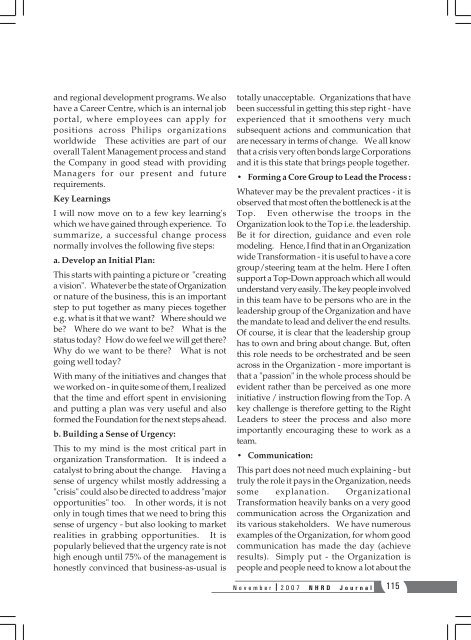NHRD Journal - National HRD Network
NHRD Journal - National HRD Network
NHRD Journal - National HRD Network
You also want an ePaper? Increase the reach of your titles
YUMPU automatically turns print PDFs into web optimized ePapers that Google loves.
and regional development programs. We also<br />
have a Career Centre, which is an internal job<br />
portal, where employees can apply for<br />
positions across Philips organizations<br />
worldwide These activities are part of our<br />
overall Talent Management process and stand<br />
the Company in good stead with providing<br />
Managers for our present and future<br />
requirements.<br />
Key Learnings<br />
I will now move on to a few key learning's<br />
which we have gained through experience. To<br />
summarize, a successful change process<br />
normally involves the following five steps:<br />
a. Develop an Initial Plan:<br />
This starts with painting a picture or "creating<br />
a vision". Whatever be the state of Organization<br />
or nature of the business, this is an important<br />
step to put together as many pieces together<br />
e.g. what is it that we want? Where should we<br />
be? Where do we want to be? What is the<br />
status today? How do we feel we will get there?<br />
Why do we want to be there? What is not<br />
going well today?<br />
With many of the initiatives and changes that<br />
we worked on - in quite some of them, I realized<br />
that the time and effort spent in envisioning<br />
and putting a plan was very useful and also<br />
formed the Foundation for the next steps ahead.<br />
b. Building a Sense of Urgency:<br />
This to my mind is the most critical part in<br />
organization Transformation. It is indeed a<br />
catalyst to bring about the change. Having a<br />
sense of urgency whilst mostly addressing a<br />
"crisis" could also be directed to address "major<br />
opportunities" too. In other words, it is not<br />
only in tough times that we need to bring this<br />
sense of urgency - but also looking to market<br />
realities in grabbing opportunities. It is<br />
popularly believed that the urgency rate is not<br />
high enough until 75% of the management is<br />
honestly convinced that business-as-usual is<br />
totally unacceptable. Organizations that have<br />
been successful in getting this step right - have<br />
experienced that it smoothens very much<br />
subsequent actions and communication that<br />
are necessary in terms of change. We all know<br />
that a crisis very often bonds large Corporations<br />
and it is this state that brings people together.<br />
• Forming a Core Group to Lead the Process :<br />
Whatever may be the prevalent practices - it is<br />
observed that most often the bottleneck is at the<br />
Top. Even otherwise the troops in the<br />
Organization look to the Top i.e. the leadership.<br />
Be it for direction, guidance and even role<br />
modeling. Hence, I find that in an Organization<br />
wide Transformation - it is useful to have a core<br />
group/steering team at the helm. Here I often<br />
support a Top-Down approach which all would<br />
understand very easily. The key people involved<br />
in this team have to be persons who are in the<br />
leadership group of the Organization and have<br />
the mandate to lead and deliver the end results.<br />
Of course, it is clear that the leadership group<br />
has to own and bring about change. But, often<br />
this role needs to be orchestrated and be seen<br />
across in the Organization - more important is<br />
that a "passion" in the whole process should be<br />
evident rather than be perceived as one more<br />
initiative / instruction flowing from the Top. A<br />
key challenge is therefore getting to the Right<br />
Leaders to steer the process and also more<br />
importantly encouraging these to work as a<br />
team.<br />
• Communication:<br />
This part does not need much explaining - but<br />
truly the role it pays in the Organization, needs<br />
some explanation. Organizational<br />
Transformation heavily banks on a very good<br />
communication across the Organization and<br />
its various stakeholders. We have numerous<br />
examples of the Organization, for whom good<br />
communication has made the day (achieve<br />
results). Simply put - the Organization is<br />
people and people need to know a lot about the<br />
November 2007 <strong>N<strong>HRD</strong></strong> <strong>Journal</strong> 115
















